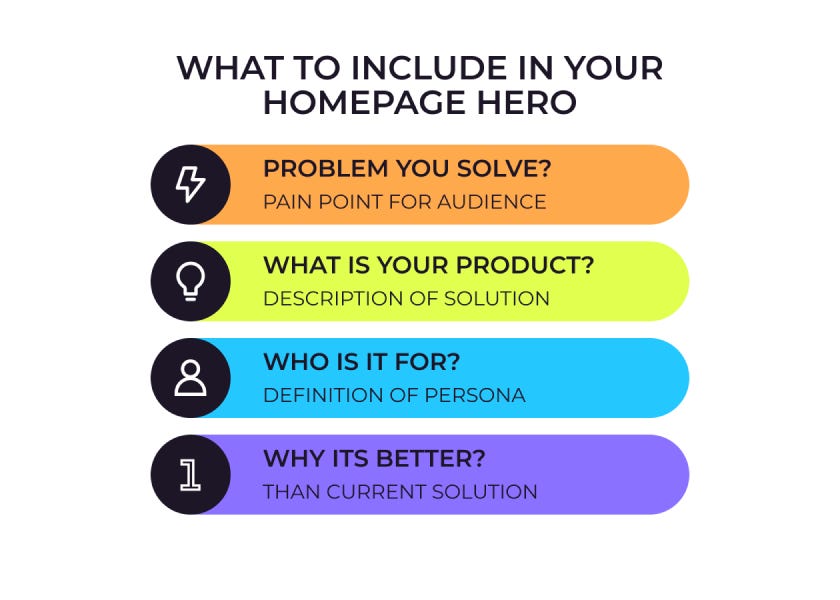Creating an Effective Homepage: Key Strategies Revealed
Concepts de base
The author emphasizes the importance of clear messaging and layout on a homepage to improve conversion rates and effectively communicate with the audience.
Résumé
Creating an effective homepage involves crafting concise messaging, planning a user-friendly layout, and using compelling copy. The key is to focus on the target audience, differentiate from competitors, and ensure clarity in communication. By following a structured approach outlined by the author, startups can enhance their online presence and drive better results.
Personnaliser le résumé
Réécrire avec l'IA
Générer des citations
Traduire la source
Vers une autre langue
Générer une carte mentale
à partir du contenu source
Voir la source
mkt1.substack.com
How to create a more effective homepage
Stats
"4 hour course on website conversion Next Workshop in January"
"50+ B2B startups"
"9 pages too long"
"3 clear steps"
"over 50% of the startups I work with use it"
Citations
"Your homepage can’t possibly explain everything you do. Focus on your wedge in, your “land” use case or the most urgent pain point."
"Don’t try to speak to everyone: Speak to the majority of your TAM or your primary audience."
"Be clear over clever: When it comes to early & growth-stage startup websites, clear copy wins over clever copy."
Idées clés tirées de
by Emily Kramer... à newsletter.mkt1.co 02-26-2024
https://newsletter.mkt1.co/p/homepage-copy
Questions plus approfondies
How can startups balance being comprehensive while maintaining clarity on their homepage?
Startups can balance being comprehensive while maintaining clarity on their homepage by focusing on their unique value proposition and key messaging points. It's essential to prioritize the most critical information that conveys what the company does, who it serves, and why its product is better than competitors. By creating a simple messaging guide with top-level building blocks, startups can ensure that their copy is concise yet informative. Additionally, using clear and compelling copy that passes the read-out-loud test helps in conveying the message effectively without overwhelming visitors with unnecessary details. Incorporating visuals such as product shots or diagrams can also enhance understanding without sacrificing clarity.
What are the risks associated with modeling a website after late-stage companies for early-stage startups?
Modeling a website after late-stage companies for early-stage startups poses several risks:
Lack of brand awareness: Early-stage startups often lack brand recognition compared to established companies. Copying the website layout or content of a well-known company may not resonate with visitors who are unfamiliar with the startup.
Overlooking educational aspects: Late-stage companies may assume that visitors already understand their industry or product offerings due to existing market presence. However, early-stage startups need to focus on educating potential customers about their solutions, which might differ significantly from those of established players.
Misalignment with audience needs: Late-stage companies have likely evolved over time based on customer feedback and market trends. By mimicking these websites, early-stage startups risk missing out on addressing specific pain points or requirements unique to their target audience.
Limited differentiation: Late-stage companies have already established themselves in the market and may not need to emphasize certain aspects like credibility or proof points as much as an early startup would.
How does personalizing content based on visitor type impact overall website effectiveness?
Personalizing content based on visitor type can significantly impact overall website effectiveness by enhancing user experience and increasing engagement levels:
Improved relevance: Tailoring content to match visitor preferences, behaviors, or demographics makes it more relevant and appealing to individual users.
Enhanced conversion rates: Personalized content resonates better with visitors, leading to higher conversion rates as they are more likely to take desired actions such as signing up for demos or requesting more information.
3.Increased retention: Visitors are more likely to stay longer on a site that provides personalized recommendations or information tailored specifically to their needs.
4.Better targeting: Personalization allows for targeted messaging towards different segments of your audience, ensuring that each group receives relevant information that speaks directly to them.
By leveraging data-driven insights and segmentation strategies for personalization efforts, businesses can create a more engaging and effective user experience leading ultimately leads towards achieving business goals efficiently
0
